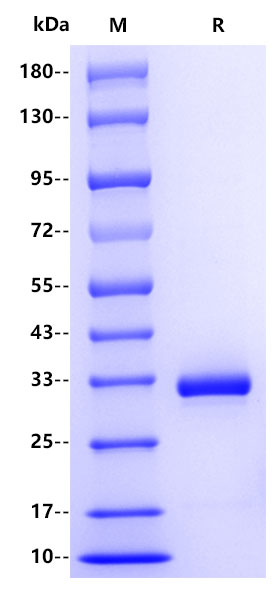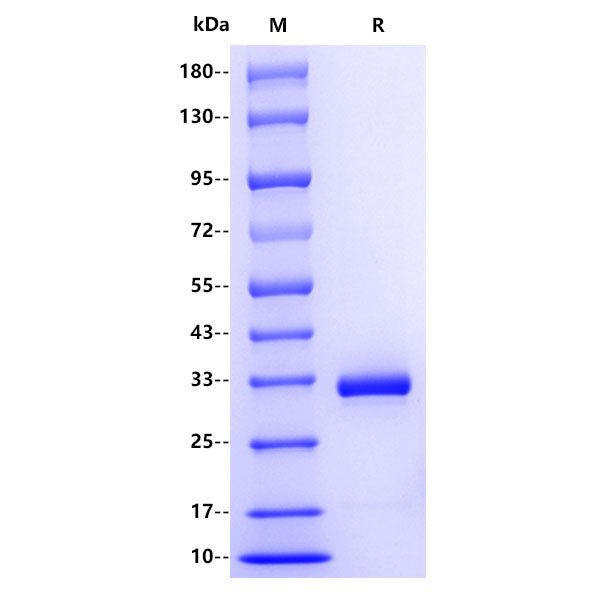2μg (R: reducing conditions)
Product Details
Product Details
Product Specification
| Species | Mouse |
| Synonyms | Granzyme B, CTLA-1, Cytotoxic cell protease 1 (CCP1), Fragmentin-2 |
| Accession | P04187 |
| Amino Acid Sequence | Protein sequence(P04187, Lys17-Ser247, with C-10*His) KAGEIIGGHEVKPHSRPYMALLSIKDQQPEAICGGFLIREDFVLTAAHCEGSIINVTLGAHNIKEQEKTQQVIPMVKCIPHPDYNPKTFSNDIMLLKLKSKAKRTRAVRPLNLPRRNVNVKPGDVCYVAGWGRMAPMGKYSNTLQEVELTVQKDRECESYFKNRYNKTNQICAGDPKTKRASFRGDSGGPLVCKKVAAGIVSYGYKDGSPPRAFTKVSSFLSWIKKTMKSSGGGGSHHHHHHHHHH |
| Expression System | HEK293 |
| Molecular Weight | Theoretical:27.4kDa Actual:31kDa |
| Purity | >95% by SDS-PAGE |
| Endotoxin | <1EU/μg |
| Tag | His Tag |
| Physical Appearance | Lyophilized Powder |
| Storage Buffer | Lyophilized from a 0.2 μm filtered solution of 0.2M PBS, pH7.4. |
| Reconstitution | Reconstitute no more than 1 mg/mL according to the size in deionized water after rapid centrifugation. |
| Stability & Storage | 12 months from date of receipt, -20 to -70 °C as supplied. 6 months, -20 to -70 °C under sterile conditions after reconstitution. 1 week, 2 to 8 °C under sterile conditions after reconstitution. Please avoid repeated freeze-thaw cycles. |
Background
Granzyme B (GZMB) is one of the serine protease granzymes most commonly found in the granules of natural killer cells (NK cells) and cytotoxic T cells. It is secreted by these cells along with the pore forming protein perforin to mediate apoptosis in target cells.Granzyme B has also been found to be produced by a wide range of non-cytotoxic cells ranging from basophils and mast cells to smooth muscle cells. The secondary functions of granzyme B are also numerous. Granzyme B has shown to be involved in inducing inflammation by stimulating cytokine release and is also involved in extracellular matrix remodelling.
Picture
Picture
SDS-PAGE



